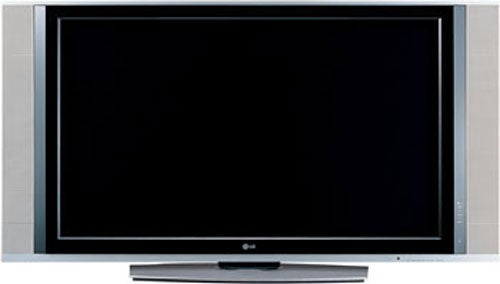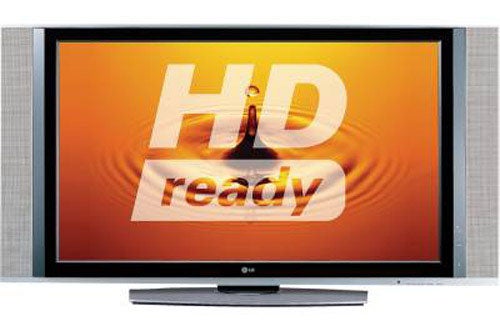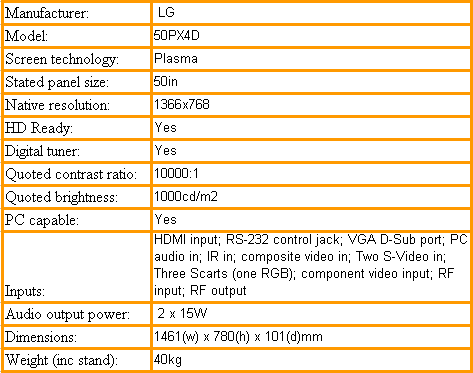LG 50PX4D 50in plasma TV Review
LG 50PX4D 50in plasma TV
A huge plasma TV at an amazing price.

Verdict
Key Specifications
- Review Price: £2300.00
You really don’t have to look very deeply into LG’s 50PX4D to see why we’re starting this review with a big grin on our faces. For yes, the price shown above is correct, and this really is a 50in plasma TV on sale for just £2,300.
That makes it cheaper than many 42in plasmas, and even gets it within touching distance of 50in DLP rear projection sets. So if you fancy DLP levels of screen size/value but in a flat-panel body, the 50PX4D could be the answer to your prayers.
Especially as it doesn’t only depend on its sheer flatness and price for its ‘love at first sight’ appeal. With its jazzy, high-gloss black screen surround inset within a chic and surprisingly robust silvery outer frame, it really is a sight for sore eyes.

The good first impressions continue with its connections, too, as far from the price-induced compromises we might have expected it actually proves better connected than many full-price rivals. For instance, you get three SCARTs where many flat TVs only offer two; a PC D-Sub computer input; slots for the direct playback of MP3s and JPEGs from various formats of multimedia memory cards; and, of course, HDMI and component video options for our beloved high definition sources. Admittedly there’s only one of each of these HD options, but given the set’s price and the abundance of other jacks, we’re not going to get too hung up on this.
The 50PX4D secures itself HD Ready status with a sufficiently high native pixel resolution of 1,366 x 768, and compatibility with the required 720p and 1080i HD formats. Probably the star turn among its specifications, though, is a claimed contrast ratio of 10,000:1 – easily the most impressive such figure we’ve seen so far. Of course, whether the LG really has the contrast range to justify such a huge figure or whether it’s just a result of some creative contrast measuring techniques remains to be seen.
Gratifyingly for such an affordable 50in plasma, the 50PX4D carries a built-in digital tuner. And this comes complete with support for the 7-day Freeview electronic programme guide. The only pity is that this EPG support is slightly limited, in that you can’t set reminders or timer recording events simply by selecting programmes from the EPG listings.
Regular readers will know that most manufacturers these days include on their LCD or plasma TVs some sort of fancily-monikered picture-boosting system. And LG is no different, managing to put its XD Engine II system even on such a price-conscious product as the 50PX4D.
XD Engine II, as with similar systems, incorporates a whole bunch of more or less significant picture processing sub-systems. And it would seem someone in the LG branding department must have had a slow weekend, for every one of the XD Engine’s sub-systems also has its very own catchy name: OptiGrade, VistaBright, PurePalette, ContrastPRO, CrystalVue and Real Cinema.

Covering each in order, we’ve got a system for boosting the subtlety of colour gradations; a brightness booster; a system for making colours look richer; a contrast range expander; a sharpness enhancer; and a system for making movement look more natural when watching films as opposed to TV shows. So now you know.
You’re probably already thinking that the 50PX4D carries more features than you’d expect of such an amazingly affordable 50in TV – but we’re not done yet. Also ramping up the 50PX4D’s value appeal are a picture in picture system, various noise reduction systems, multiple techniques for avoiding plasma’s ‘screenburn’ troubles, and even separate adjustments for the skin-, green- and blue-tones.
Surely all this fancy feature posturing must be a ruse to hide the fact that the budget 50PX4D’s pictures aren’t up to much, right? Wrong.
For starters the 50PX4D – perhaps thanks to the XD Engine – does a sterling job of realising all the wonderful little fine details that make high definition sources so special. In fact, high definition pictures look as textured, three-dimensional and clear as we’ve seen them on any 50in plasma TV, irrespective of price.
The detailing aspect of the XD Engine’s capabilities makes standard definition sources look sharper than usual too – even the notoriously soft and fluffy-looking broadcasts received by the onboard digital tuner.
Next, while we still feel 10000:1 is deeply optimistic as a contrast ratio claim, there’s no denying that the 50PX4D’s black levels are strikingly good for a flat TV. This means that dark scenes like, oh, almost the whole of Alien, remain pretty much entirely free of the flattening ‘grey mist’ effect that afflicts dark scenes on less able flat panel TVs. What’s more, the LG’s darkness isn’t empty; tucked away in even the blackest corner can still be found some subtle traces of shadow detailing, helping make pictures seem more three-dimensional and solid.

Yet more unexpectedly welcome news comes from the 50PX4D’s general suppression of three still-common plasma technology complaints: fizzing pixel noise over dark areas; fizzing picture noise over horizontal motion; and colour blends that appear in stripes rather than smooth gradations. Not having to put up with these nasties really helps you forge a closer connection with whatever you’re watching.
When it comes to colours, the 50PX4D is also capable of great things. With high definition, hues across the colour spectrum look dazzlingly rich and, for the most part, natural in tone.
However, colours also introduce the first of a relatively small group of niggles, as we find the naturalism of the 50PX4D’s tones and its vibrancy dropping off more than we’d like to see while watching poor-quality standard definition sources.
Niggle number two concerns the way high definition pictures sporadically seem to flicker a touch, while number three is the appearance of faint traces of MPEG blocking noise while watching the HDMI input.
The 50PX4D’s sound, like its pictures, is way better than we’d expected from such a cut-price TV. Bass levels are reasonably deep, well controlled and convincing; voices are always clear no matter how OTT the rest of a sound mix might get; and the soundstage is brought to life by oodles of harshness-free treble detailing.
”’Verdict”’
Don’t be put off by the crazily low price: with the 50PX4D you for once get a hell of a lot more than you pay for. In fact, if you can take its slight standard definition weaknesses out of the equation by feeding it a predominantly HD diet, it’s borderline irresistible.

How we test televisions
We test every TV we review thoroughly over an extended period of time. We use industry standard tests to compare features properly. We’ll always tell you what we find. We never, ever, accept money to review a product.
Trusted Score
Score in detail
-
Value 10
-
Image Quality 8
-
Sound Quality 8

